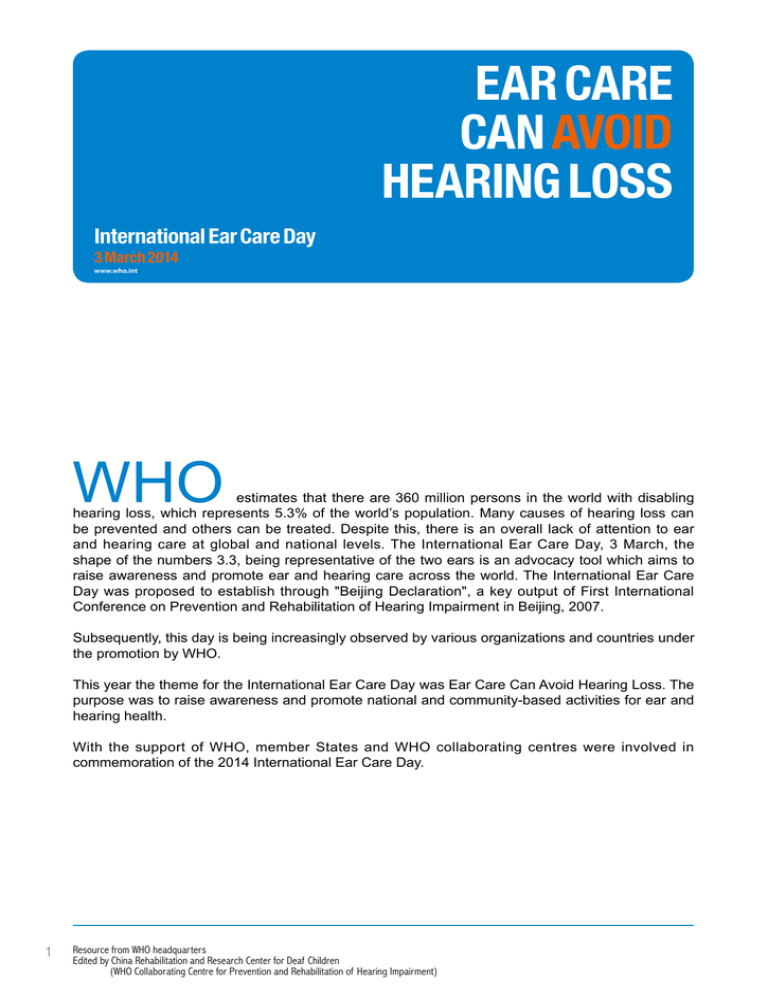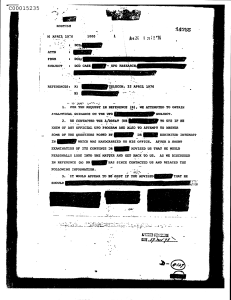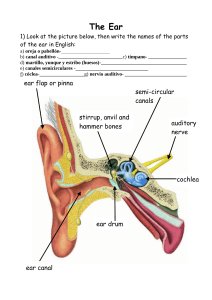estimates that there are 360 million persons in the world with
Anuncio

WHO estimates that there are 360 million persons in the world with disabling hearing loss, which represents 5.3% of the world’s population. Many causes of hearing loss can be prevented and others can be treated. Despite this, there is an overall lack of attention to ear and hearing care at global and national levels. The International Ear Care Day, 3 March, the shape of the numbers 3.3, being representative of the two ears is an advocacy tool which aims to raise awareness and promote ear and hearing care across the world. The International Ear Care Day was proposed to establish through "Beijing Declaration", a key output of First International Conference on Prevention and Rehabilitation of Hearing Impairment in Beijing, 2007. Subsequently, this day is being increasingly observed by various organizations and countries under the promotion by WHO. This year the theme for the International Ear Care Day was Ear Care Can Avoid Hearing Loss. The purpose was to raise awareness and promote national and community-based activities for ear and hearing health. With the support of WHO, member States and WHO collaborating centres were involved in commemoration of the 2014 International Ear Care Day. 1 Resource from WHO headquarters Edited by China Rehabilitation and Research Center for Deaf Children (WHO Collaborating Centre for Prevention and Rehabilitation of Hearing Impairment) Activities in WHO Headquarters On 28 February 2014, WHO-HQ held a press briefing at Palais des Nations in Geneva, on the situation on hearing loss in Member States and WHO regions and on their capacity to provide ear and hearing care. The PBD unit in collaboration with WHO-Health and Medical Services provided free ear and hearing check-up to the WHO staff, former staff and their families at the WHO-HQ as well as ear care education and advice. A total of 153 persons were screened of which 31 were referred for further investigations. A brochure was freely provided after the screening which further elaborated how to care for the ear, in the form of frequently asked questions. On 3 March, the report on “Multi-Country Assessment of National Capacity to Provide Hearing Care” was launched by Dr Etienne Krug, Director Injuries and Violence Prevention, Disability and Rehabilitation. برعاية األذن تتفادى فقد السمع تدخل أي يشء يف األذن ال تستخدم عالجات منزلية يف األذن تستمع للموسيقى الصاخبة Design by Inís Communication – www.iniscommunication.com Awareness materials including posters, banners, flyers and videoclip were developed for use by partners and Member States. were developed for use by partners and Member States. عند الشكوى من مشكلة يف األذن راجع الطبيب ال ال اليوم العاملي لرعاية األذن 2014 مارس/ آذار3 www.who.int Internet campaign: An internet campaign was launched using the WHO website and social media. Facebook, Twitter, Google plus, YouTube and LinkedIn were actively involved with International Ear Care Day and enhanced the visibility and awareness for Ear Care. Twitter registered engagements of 15.8 million exposures and over 3 million accounts reached through tweets and retweets from 27 February to 3 March 2014. Facebook registered a total of 1830 likes, 922 shares and 47 comments while You-Tube had a total of over 12 500 viewers in English, French and Spanish. Google plus recorded 476 comments on the Ear Care Day posts. 2 Resource from WHO headquarters Edited by China Rehabilitation and Research Center for Deaf Children (WHO Collaborating Centre for Prevention and Rehabilitation of Hearing Impairment) The First International Conference on Prevention and Rehabilitation of Hearing Impairment, held in Beijing, China in 2007. An outcome of this conference was the Beijing declaration, which called upon all members to observe 3 March as the International Ear Care Day. This year, as usual (The first National Ear Care Day started in 2000 in China.) China as the initiator of IECD,continued to organize nation-wide activities, with involvement of the China Disabled Persons’ Federation, National Health and Family Planning Commission and 13 other ministries. Numerous activities were held across the country reaching nearly 60% of the Chinese population. Activities ranged from community awareness camps, to nation-wide media campaign, free hearing screening, consultations as well as hearing aid fitting. Text messages on ear care were sent to mobile phone users by all state owned telecom companies. As with the previous years, a theme concert was organized in Beijing and attended by officials from 15 ministries and the WHO Representative to China. Concerts were also organized in 4 other cities of China. The activities involved 6551communities, towns and villages, 713 cities and counties. 4230 professionals and 273 expert teams throughout the country. 2624 promotional posters were put up and 9 043 152 pamphlets were mailed out as part of the educational campaign. 296 387 persons received free hearing screenings and consulting services. Donations from all the society included 4,902 hearing aids and other daily living goods worth more than 0.93million Yuan RMB. The three WHO collaborating centres for prevention of deafness, China Research and Rehabilitation Centre for Deaf Children (CRRCDC), Beijing Tongren Hospital and Nanjing Hospital participated in the events. CRRCDC plays a lead role in planning and execution of ear care day activities in the entire country. 3 Resource from WHO headquarters Edited by China Rehabilitation and Research Center for Deaf Children (WHO Collaborating Centre for Prevention and Rehabilitation of Hearing Impairment) A media conference at national level was hosted by CRRCDC to announce the theme. 2310 media agencies got involved reporting of relevant activities. China Centre Te l e v i s i o n r e l e a s e d news and reports of IECD, including the interview of WHO representative in China. Special training courses on neonatal hearing screening were organized in t h e L a n z h o u c i t y, Gansu province. All WHO materials were translated and used for advocacy. Events from Member States Australia: Community level awareness camp was organized by the Derbarl Yerrigan Health service Inc in Mandurah. Awareness materials were used to sensitize community members and health promotion staff. Bahrain: the Ministry of Health organized an awareness campaign using television shows and community awareness sessions to promote the day. Hearing screening was organized for children and awareness materials provided. Bangladesh: the National ENT and Head and Neck Foundation of Bangladesh led the organization of events, with participation from the WHO country office. Awareness activities were carried out and a free ear and hearing camp was organized. The Centre for Disability in Development, an NGO working in Bangladesh also held awareness camps to mark the day. Colombia: Under the leadership of the national coordinator for hearing health, awareness materials were developed and displayed on the occasion of the IECD. Democratic Republic of Congo: District level activities were carried out with the involvement of the WHO district office. Community awareness sessions were organized in schools, short ear care messages were conveyed through local media and distribution of awareness materials done. Over 10 000 people were reached through the activities. Guatemala: The Ministry of Health, in collaboration with the Disability programme, organized awareness sessions regarding ear care and problems of ear and hearing. Guinea: The Ministry of Health of Guinea launched a week long campaign. Raising awareness in the community regarding prevention of hearing loss was the focus. A declaration was made by the Minister of Health and televised through the national channels. Clinical screening activities were undertaken throughout the week and free hearing aid fitting provided. India: An awareness camp for schoolchildren was organized by the Society for Sound Hearing on 3 March and in Hyderabad by the Rajiv Gandhi Institute of Medical Sciences. Indonesia: The Jakarta WHO Collaborating Centre organized activities at the Dr. Cipto Mangunkusumo National Hospital, Hearing screening was performed on hospital staff working in noisy areas. Awareness activities were undertaken and an ‘ear care day pin’ provided to all staff and visitors. Kuwait: The Ministry of Health, along with national professional bodies organized the ear care day campaign on 3 March. Over 15 000 people were reached through activities which included screening, service provision and community awareness. A two-week long advocacy campaign was carried out. Innovative materials on ear care were prepared and distributed. 4 Resource from WHO headquarters Edited by China Rehabilitation and Research Center for Deaf Children (WHO Collaborating Centre for Prevention and Rehabilitation of Hearing Impairment) Madagascar: The SALFA hospital in Madagascar organized the ear care activities with a free ear care camp in the capital city, Antananarivo, on 3 March, and a camp in Antsirabe the following week. Nigeria: Ear care day activities were carried out in the 6 geopolitical zones of the country. An advocacy campaign involving local radio stations, health talks and community awareness sessions was carried out. Ear and hearing screening activities were undertaken at a number of places across the country. Local leaders and government officials were involved in the organization and conduct of activities. Pakistan: Community awareness programmes were organized in Karachi during the month of March to mark the IECD, with the participation of the WHO country office. An awareness walk was organized on the Ear Care Day in Lahore, with participation of the leading otolaryngologists, academicians, students and media. Peru: Activities for raising awareness on ear care were organized by the Hospital Nacional Dos de Mayo, Lima in Peru. Qatar: Four-day activities were carried out in Qatar focussing on the theme “Mom and Dad, your Hearing is important for us”. The National Program for Early Detection of Hearing loss in Elderly People was announced on the day. Awareness materials were developed and a number of activities were carried out including an awareness campaign through newspaper, radio and television. Awareness activities targeted elderly persons, schoolchildren and primary health care providers. Rwanda: A number of activities were organized, including a peaceful march in the city of Kigali. Flyers on ear care were distributed and programmes aired over radio and television. A free ear check-up camp was conducted. Seychelles: Activities were organized with the participation of the Ministry of Health in Seychelles. Hearing screening, distribution of leaflets and awareness sessions on ear care were carried out from 3 March. District clinics were also involved in these activities. South Africa: IECD activities were organized in the rural areas of Elandsdoorn. A range of awareness activities took place over a 3-day period targeting students, teachers, parents and health professionals. A Facebook page www.facebook.com/hearinafrica was also launched on this day. 5 Resource from WHO headquarters Edited by China Rehabilitation and Research Center for Deaf Children (WHO Collaborating Centre for Prevention and Rehabilitation of Hearing Impairment) Swaziland: The IECD was marked by the participation of the Minister of Health of Swaziland and supported by the WHO country office. A slogan of ‘Make hearing matter’ was adopted. Advocacy events and community awareness activities were carried out between 24 February and 7 March. Rural camps for hearing screening were conducted and radio, TV shows and newspaper articles have been organized for the entire month of March. The advocacy events targeted policy makers, with participation of Minister of Health for Swaziland, WHO Representative to Swaziland, members of health services, parents and teachers. Zanzibar, Tanzania: Primary Ear and Hearing care day was celebrated on 4 March, under the leadership of the Zanzibar Outreach Programme and in collaboration with the Ministry of Health. Over the last one year, Zanzibar has developed 35 Primary Ear and Hearing Clinics and one referral hospital. Links to International Ear Care Day news and publications Africa: • • • • • • • • CBM Kenya http://kenya.cbm.org/International-Ear-and-Hearing-day-2014-443246.php Citi 97.3 fm Ghana http://www.citifmonline.com/?p=3539 Vibe Ghana http://vibeghana.com/014/03/04/who-says-many-countries-lack-capacity/ Naijatowncrier Nigeria http://naijatowncrier.com/360m-people-deaf-says-who/ NAN Nigeria http://www.nanngronline.com/section/healthgender/360m-people-suffer-from-hearing-losswho PM news Nigeria http://www.pmnewsnigeria.com/2014/03/03/360m-people-deaf-says-who/ NewsPoint Africa South Africa http://newspoint.co.za/story/414/5508-360-million-suffering-disablinghearing-loss-worldwide Star Africa (Cameroon, Egypt, Ghana, Kenya, Nigeria, South Africa) http://en.starafrica.com/news/newwho-survey-many-countries-lack-capacity-to-prevent-and-treat-hearing-loss.html Americas: • • 6 Voice of America http://www.voanews.com/content/hearing-loss-children-infection-ear-healthafrica/1865536.html Caribbean Observer http://www.antiguaobserver.com/caribbean-health-caribbean-urged-to-invest-inprevention-and-care-for-hearing-loss/ Resource from WHO headquarters Edited by China Rehabilitation and Research Center for Deaf Children (WHO Collaborating Centre for Prevention and Rehabilitation of Hearing Impairment) • • Mediaforfreedom.com US http://mediaforfreedom.com/readarticle.php?AID=18236 PAHO: http://www.paho.org/hq/index.php?option=com_content&view=article&id=9345%3A many-countries-lack-capacity-to-prevent-and-treat-hearing-loss&catid=1443%3Anews-front-pageitems&lang=en&itemid=1926 Europe: • • Balkans.com http://www.balkans.com/open-news.php?uniquenumber=189857 Journal of Laryngology and Otology(2014) 122, 221-222 Editorial on the International Ear Care Day Wordpress.com Cambridge http://cambridgemedicine.wordpress.com/2014/03/03/international-earcare-day-2014/ Welfare Society Territory (WEST) http://www.west-info.eu/ear-care-day-2014-a-day-to-let-hear-ourvoice/ Interaksyon news Geneva http://www.interaksyon.com/article/81798/over-5-of-worlds-populationsuffer-from-disabling-hearing-loss----who • • • Asia: • • • • • • UN: • • • • • • 7 Bernama.com, Malaysia http://www.bernama.com.my/bernama/v7/wn/newsworld.php?id=1018408 National news agency http://www.bernama.com/bernama/v7/ge/newsgeneral.php?id=1018408 Singapore http://www.biospectrumasia.com/biospectrum/news/210058/asia-lacks-capacity-preventcare-hearing-loss-who-survey Manila bulletin http://www.mb.com.ph/over-5-of-worlds-population-suffer-from-disabling-hearing-losswho/ Manila times http://manilatimes.net/who-over-5-of-worlds-population-suffer-from-disabling-hearingloss/79265/ Shanghai China http://www.shanghaidaily.com/article/article_xinhua.aspx?id=203881 Humanitarian news http://humanitariannews.org/20140228/many-countries-lack-capacity-preventtreat-hearing-loss UN health agency article and news http://article.wn.com/view/2014/02/28/UN_health_agency_calls_ on_countries_to_invest_in_prevention_/ UN radio http://www.unmultimedia.org/radio/english/2014/03/international-ear-care-day-highlightshearing-loss-problem/ Audiology world news http://www.audiology-worldnews.com/news Journal of Laryngology and Otology http://www.unboundmedicine.com/medline/ub?cmd=fulltext&ref=http://journals.cambridge.org/ abstract_S0022215114000413 UN News: http://www.un.org/news/dh/pdf/english/2014/28022014.pdf Resource from WHO headquarters Edited by China Rehabilitation and Research Center for Deaf Children (WHO Collaborating Centre for Prevention and Rehabilitation of Hearing Impairment)

